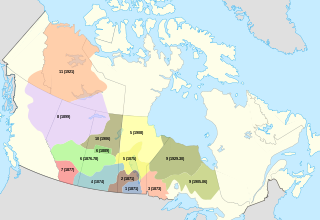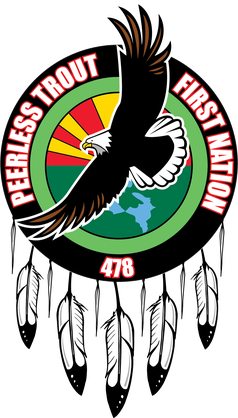
The Cree are a North American Indigenous people. They live primarily in Canada, where they form one of the country's largest First Nations.
The Northern Alberta Institute of Technology (NAIT) is a polytechnic and applied sciences institute in Edmonton, Alberta, Canada. NAIT provides careers programs in applied research, technical training, applied education, and learning designed to meet the demands of Alberta's technical and knowledge-based industries. NAIT offers approximately 120 credit programs leading to degrees, applied degrees, diplomas, and certificates. As of 2018, there are approximately 16,000 students in credit programs, 12,000 apprentices registered in apprenticeship training, 14,500 students enrolled in non-credit courses, and more than 20,000 registrants for customized corporate based training. NAIT also attracts international students from 94 countries. NAIT is similar to an Institute of technology or university of applied sciences as termed in other jurisdictions. The campus newspaper, the NAIT Nugget, is a member of the Canadian University Press (CUP).

The Pi'ikanni Nation is a First Nation, representing the Indigenous people in Canada known as the Northern Piikani or simply the Peigan.
A tribal council is an association of First Nations bands in Canada, generally along regional, ethnic or linguistic lines.
First Nations in Alberta are a group of people who live in the Canadian province of Alberta. The First Nations are peoples recognized as Indigenous peoples or Plains Indians in Canada excluding the Inuit and the Métis. According to the 2011 Census, a population of 116,670 Albertans self-identified as First Nations. Specifically there were 96,730 First Nations people with registered Indian Status and 19,945 First Nations people without registered Indian Status. Alberta has the third largest First Nations population among the provinces and territories. From this total population, 47.3% of the population lives on an Indian reserve and the other 52.7% live in urban centres. According to the 2011 Census, the First Nations population in Edmonton totalled at 31,780, which is the second highest for any city in Canada. The First Nations population in Calgary, in reference to the 2011 Census, totalled at 17,040. There are 48 First Nations or "bands" in Alberta, belonging to nine different ethnic groups or "tribes" based on their ancestral languages.

Treaty 6 is the sixth of the numbered treaties that were signed by the Canadian Crown and various First Nations between 1871 and 1877. It is one of a total of 11 numbered treaties signed between the Canadian Crown and First Nations. Specifically, Treaty 6 is an agreement between the Crown and the Plains and Woods Cree, Assiniboine, and other band governments at Fort Carlton and Fort Pitt. Key figures, representing the Crown, involved in the negotiations were Alexander Morris, Lieutenant Governor of the North-West Territories; James McKay, The Minister of Agriculture for Manitoba; and W.J. Christie, the Chief Factor of the Hudson's Bay Company. Chief Mistawasis and Chief Ahtahkakoop represented the Carlton Cree.
First Nations in Manitoba constitute of over 160,000 registered persons as of 2021, about 57% of whom live on reserve. Manitoba is second to Ontario in total on-reserve population and in total First Nation population.

Enoch Cree Nation 135, previously known as Stony Plain No. 135, is an Indian reserve of the Enoch Cree Nation #440 in Alberta. It is adjacent to the City of Edmonton to the east and Parkland County to the north, west, and south.

The Enoch Cree Nation #440 is a First Nations band government in Alberta, Canada. Members of the Nation are of Cree ancestry and speak the Plains Cree dialect of the Cree language group. The band is a signatory of Treaty 6 and is a member of the Confederacy of Treaty Six First Nations. The chief of the Enoch Cree Nation is Cody Thomas.

J. Wilton Littlechild, known as Willie Littlechild, is a Canadian lawyer and Cree chief who was Grand Chief of the Confederacy of Treaty Six First Nations and a member of Parliament. A residential school survivor, he is known for his work nationally and internationally on Indigenous rights. He was born in Hobbema, now named Maskwacis, Alberta.
Alexander First Nation is a First Nations band government, headquartered 17 kilometres (11 mi) west of Morinville, Alberta. This First Nation is part of the Cree ethno-linguistic group, is a member of the Yellowhead Tribal Council, and is party to Treaty 6. The band controls three Indian reserves: Alexander 134, Alexander 134A, and Alexander 134B. The main reserve is bordered by Sturgeon County and Lac Ste. Anne County.
The Papaschase are a group of Cree people descended from Chief Papaschase's Band of the 19th century, who were a party to Treaty 6 with Canada. A modern-day group of Papaschase descendants are working to advance their treaty rights and reclaim their reserve's land or get compensation for its loss. They claim the reserve was surrendered unlawfully in 1888, but they have not been recognized yet by the Canadian Government Alexander First Nation #134 #134a #134b #143

The Beaver Lake Cree Nation is a First Nations band government located 105 kilometres (65 mi) northeast of Edmonton, Alberta, representing people of the Cree ethno-linguistic group in the area around Lac La Biche, Alberta, where the band office is currently located. Their treaty area is Treaty 6. The Intergovernmental Affairs office consults with persons on the Government treaty contacts list. There are two parcels of land reserved for the band by the Canadian Crown, Beaver Lake Indian Reserve No. 131 and Blue Quills First Nation Indian Reserve. The latter reserve is shared by six bands; Beaver Lake Cree Nations, Cold Lake First Nations, Frog Lake First Nation, Heart Lake First Nation, Kehewin Cree Nation, Saddle Lake Cree Nation.

The Peerless Trout First Nation is a First Nations band government in northern Alberta, Canada, that is based out of Peerless Lake. It is part of the Treaty 8 Confederacy and was formed as Alberta's forty-fifth First Nation in 2010.

The Michel Band is an Indigenous nation of central Alberta, Canada, which the Government of Canada recognized as a nation and treaty partner from 1878 to 1958. The descendents of that historic band, now organized as an association called the Michel First Nation, are engaged in legal and political action to regain recognition.
The Sharphead band was an indigenous people of what is now central Alberta, which was a part of the Stoney (Nakoda) ethno-linguistic group and was party to Treaty 6 (1876) with the Canadian Crown. The Sharphead were devastated by hunger and disease and ceased to exist as a separate people after 1897 when their reserve lands were taken by the Canadian government and the few remaining survivors were dispersed to live with other neighbouring First Nations.

Mikisew Cree First Nation is an Indigenous First Nations government of Woodland Cree people in northeastern Alberta and in Northwest Territories, Canada.
Chief Johnny Bob Smallboy, also Robert or Apitchitchiw, was a community leader who brought national attention to problems faced by urban and reserve Indians of when he "returned to the land" with followers from troubled Canadian Indian reservations.

The Big River First Nation is a part of the Cree Nation and is located in the Saskatchewan province of Canada. The Big River First Nation is also called ᒥᐢᑕᐦᐃ ᓰᐲᕁ mistahi-sîpîhk in Cree meaning "at the big river". They are signatories of Treaty 6 are located close to Pelican Lake Ojibway, the Big River and Prince Albert National Park. They are 120 km northwest of the city of Prince Albert and 19 km southwest of the village of Debden. The Big River First Nation has nearly 30,000 acres of reserve land. Their reserves include-

The Lubicon Lake Band is a Cree First Nations band government in northern Alberta, Canada. Missed by government agents during the signing of Treaty 8 in 1899, the Lubicon community was long without federal support. Seeking to have their traditional title acknowledged through the creation of an Indian reserve, Lubicon representatives have maintained an active land claim since 1933. As oil and gas development changed the face of Alberta, development on Lubicon land became an increasingly pressing issue. Between 1979 and 1982, over 400 oil and gas wells were drilled around the community of Little Buffalo, the band's headquarters. Most prominently, the nation mounted a protest campaign during the 1988 Winter Olympics in Calgary, blockading roads crossing its traditional territory in October of the same year.










